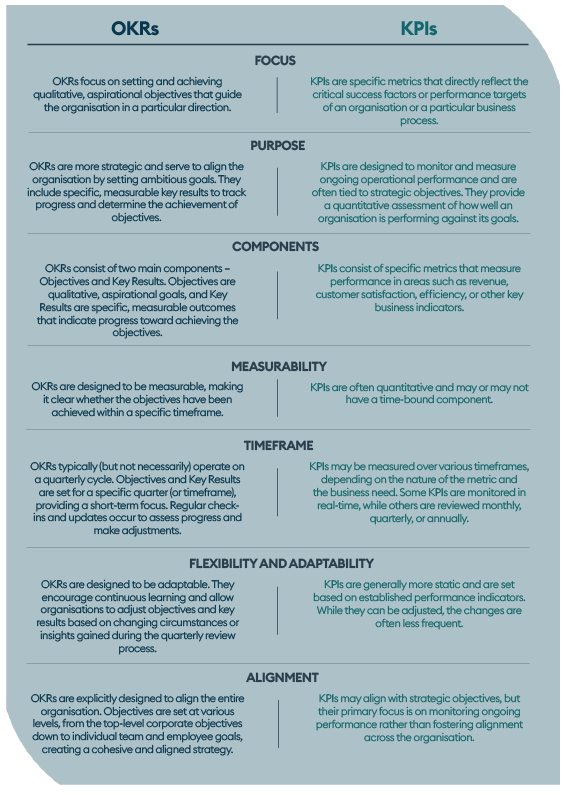OKRs vs KPIs: Why it’s important to strike a balance between the two.
In the evolving landscape of business management, setting goals and tracking performance is a pivotal practice. Objectives and Key Results (OKRs) and Key Performance Indicators (KPIs) are two popular performance management frameworks that help businesses articulate and measure their objectives.
While both play a fundamental role in driving performance, they serve distinct purposes and are best employed under specific circumstances. OKRs and KPIs differ in their focus, structure, and purpose. This article will assist readers to distinguish between the two and assist you in deciphering which one is most suitable for the needs of your organisation.
Distinguishing between OKRs and KPIs
OKRs are a goal-setting framework that originated in Silicon Valley and gained prominence through its adoption by tech giants like Google. OKRs consist of two main components:
- Objectives: broad, qualitative statements that define what the organisation aims to achieve. Objectives are typically ambitious and time-bound, providing direction for the entire organisation; and
- Key Results: Measurable, quantitative outcomes that indicate progress toward achieving the objectives. Key Results are specific, concrete, and ideally, challenging yet attainable.
OKRs are designed to foster alignment and transparency within an organisation. They encourage employees to focus on ambitious goals while providing a clear roadmap for success. OKRs are typically set quarterly, promoting agility and adaptability in response to changing business conditions.
KPIs, on the other hand, are metrics that track specific aspects of an organisation’s performance. KPIs are quantifiable and often relate to critical business processes. Unlike OKRs, which are more aspirational, KPIs are concrete and directly tied to ongoing operations.
KPIs are chosen based on their relevance to organisational objectives and can vary across industries and departments. Examples of KPIs include revenue growth, customer satisfaction scores, employee productivity, and other metrics that provide insights into performance and progress.
An integrated approach
Many organisations choose to integrate both OKRs and KPIs into their performance management systems. OKRs provide a strategic framework for setting ambitious goals, while KPIs offer a more granular and ongoing measurement of performance metrics. This integrated approach allows organisations to balance the need for strategic alignment with the continuous monitoring of key operational metrics.
When to Use OKRs or KPIs
OKRs for direction and alignment
- Use OKRs when you want to set ambitious, overarching goals that align the entire organisation;
- Employ OKRs to foster transparency and ensure that everyone is working towards common objectives; and
- Choose OKRs when adaptability and agility are crucial, as they are often set and reviewed on a quarterly basis.
KPIs for Operational Performance
- Utilise KPIs when you need to monitor and assess ongoing processes and performance;
- KPIs are ideal for measuring the success of day-to-day operations and ensuring that key business metrics are on track; and
- Select KPIs when you require real-time insights into specific aspects of your business, such as sales, marketing, or customer service.
Implementation
After you’ve established the purpose of your performance management system, you can start implementing either OKRs, KPIs, or a combination of the two. The below steps will guide you on how to do so.
1. Implementing OKRs
Setting Objectives
- Ambitious Goals: Establish ambitious, qualitative objectives that provide direction and purpose. Objectives should be inspiring and challenging;
- Alignment: Ensure that objectives align with the overall mission and strategy of the organisation.
2. Defining Key Results
- Measurable Outcomes: For each objective, define specific, measurable, and time-bound key results that indicate progress and success;
- Quantifiable Targets: Key results should be quantifiable and reflect a level of achievement that signifies the accomplishment of the corresponding objective.
3. Alignment and Cascading
- Alignment Across Levels: Cascade objectives and key results throughout the organisation, ensuring alignment from top-level corporate objectives down to individual team and employee goals;
- Interconnectedness: Foster interconnectivity between different sets of OKRs to create a cohesive and aligned organisational strategy.
4. Regular Check-ins and Updates
- Quarterly Cadence: Review and update OKRs on a more short-term basis. This regular cadence allows for adaptability and ensures ongoing relevance;
- Progress Tracking: During check-ins, assess progress toward key results, discuss challenges, and make necessary adjustments.
5. Continuous Learning and Adaptation
- Learning from Results: Use the results of OKR assessments as a learning opportunity. Understand what worked well, and what didn’t, and apply these insights to future goal-setting;
- Adaptability: OKRs encourage adaptability, allowing organisations to pivot and adjust objectives based on changing circumstances.
Implementing KPIs
1. Identification of Key Areas
Strategic Objectives: Begin by identifying the high-level strategic objectives of the organisation or a specific department.
2. Selection of Key Performance Indicators
- Relevance: Choose KPIs that directly align with the identified strategic objectives. KPIs should reflect critical aspects of performance;
- Measurability: Ensure that each KPI is measurable, allowing for quantitative assessment and comparison over time;
- Specificity: Define KPIs in a way that provides clarity and specificity. Avoid vague or ambiguous metrics.
3. Setting Targets and Benchmarks
- Goal Setting: Establish specific targets or benchmarks for each KPI. These targets should be realistic, challenging, and achievable;
- Timeframe: Specify the timeframe for achieving the KPIs, whether it’s on a monthly, quarterly, or annual basis.
4. Regular Monitoring and Analysis
- Data Collection: Implement systems for collecting relevant data that correspond to the selected KPIs;
- Analysis: Regularly analyse the data to assess performance against the established benchmarks. Identify trends, patterns, and areas for improvement.
5. Feedback and Adjustments
- Feedback Mechanism: Provide feedback to individuals or teams based on KPI performance;
- Continuous Improvement: Use KPI data to inform strategic decisions and continuously improve processes.
Tips from top tier professionals
We had a look at what advice some top tier professionals had for us when calibrating the performance evaluation system. This is what they had to say:
- The system must be simplistic and users must have easy access to their tools to avoid burden of evaluations and feedback (Google);
- The system must come with clear instruction (Wigert & Harter, 2015);
- There must be a transparent evaluation process to increase perceptions of fairness and influences buy-in and accepting the outcome (Schleicher et al., 2018);
- 360 degree feedback enhances feedback and increases conversations among all employee levels (Tyson & Ward, 2004);
- Organisations need to constantly calibrate their evaluation processes (Deloitte); and
- Organisations must study the problems with the current system, and involve system users in solutions and testing (Google and Pulakos & Battista, 2020).
Initially, both Deloitte and Google implemented OKR’s which weren’t very successful. They both continued to work on their systems, which improved and ultimately lead to their success. What initially went wrong?
For Deloitte:
- Goal setting and calibration meetings;
- A complex rating process;
- Not differentiating and recognising performance;
- Performance not being accurately measured;
- Focusing on past actions rather than future actions for the individual being rated; and
- Lack of ‘agile’.
For Google:
- Thousands of hours every three months were dedicated to assigning ratings that were ludicrously precise but weren’t an accurate basis for determining pay;
- Lack of experimentation; and
- Ratings that weren’t fair and well understood (as they are simplifying devices to help managers make decisions about pay and promotion).
Conclusion
Both OKRs and KPIs are valuable tools for organisational success, but they serve different purposes in the realm of performance management. OKRs are best suited for setting ambitious, strategic objectives that foster alignment and transparency, while KPIs excel at providing real-time insights into ongoing operational performance.
Organisations can maximise their potential by integrating either or both frameworks, using OKRs to set the direction and KPIs to monitor the journey towards achieving those objectives. The key is to strike a balance that aligns with the organisation’s overall strategy and goals.
Dr Mark Bussin is the Chairperson at 21st Century in Johannesburg, South Africa, a Professor at the University of Johannesburg, Professor Extraordinaire at North West University, a Chairperson and Member of various boards, audit and remuneration committees, and a former Commissioner in the Presidency. Daniela Christos is an industrial psychologist.












